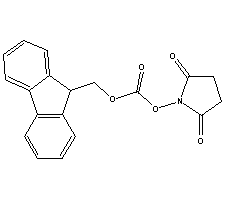FAQ
What is 9-Fluorenylmethylsuccinimidylcarbonate and how is it used in
research?
9-Fluorenylmethylsuccinimidylcarbonate, also known as Fmoc-OSu, is a common reagent
used in solid-phase peptide synthesis. It is utilized in the process of attaching amino acids to a
growing peptide chain, enabling the stepwise assembly of custom peptides with high purity and
efficiency.
How does Fmoc-OSu compare to other coupling reagents in peptide
synthesis?
Fmoc-OSu offers several advantages over alternative coupling reagents commonly
used in peptide synthesis. It is known for its compatibility with a wide range of amino acids and
its ability to facilitate efficient amide bond formation. Additionally, Fmoc-OSu is easy to work
with, making it a preferred choice for researchers looking to streamline their peptide synthesis
workflows.
What are some key considerations when using Fmoc-OSu in peptide
synthesis?
When using Fmoc-OSu in peptide synthesis, it is important to consider factors such
as reaction conditions, reagent purity, and compatibility with other reagents and solvents. Proper
storage and handling of Fmoc-OSu are also critical to ensuring optimal results and minimizing the
risk of side reactions or impurities in the final peptide product.
Can Fmoc-OSu be used in
combination with other reagents for specialized peptide synthesis applications?
Yes, Fmoc-OSu
can be combined with other reagents and strategies to achieve specific goals in peptide synthesis.
For example, researchers may use Fmoc-OSu in conjunction with cleavage agents, protecting groups, or
other coupling reagents to customize their peptide synthesis protocols based on the desired
sequence, structure, or properties of the target peptide.
In conclusion, Fmoc-OSu is a
versatile and reliable reagent that plays a crucial role in solid-phase peptide synthesis. Its
compatibility with various amino acids, ease of use, and capacity for customization make it a
valuable tool for researchers working in the field of peptide chemistry. By understanding the
advantages and considerations associated with Fmoc-OSu, scientists can leverage this powerful
reagent to advance their peptide synthesis projects and achieve high-quality results.


